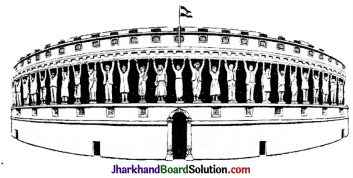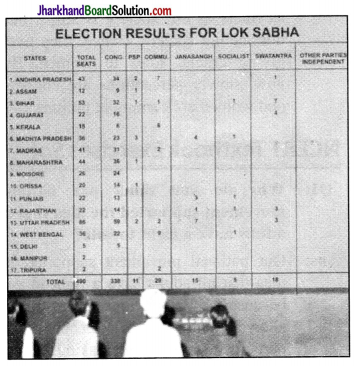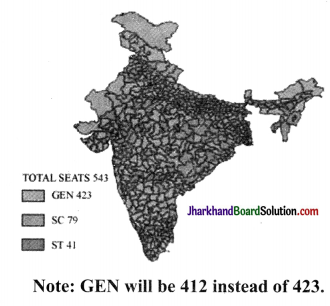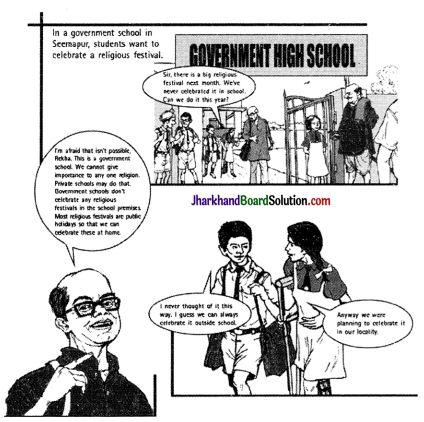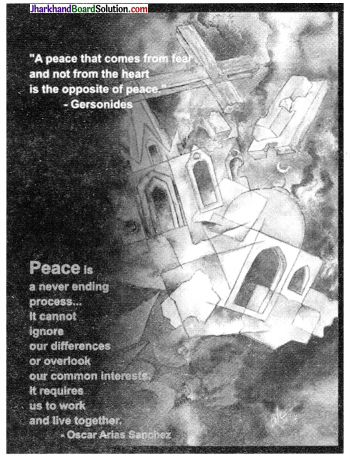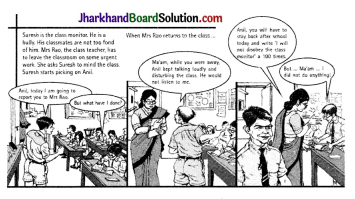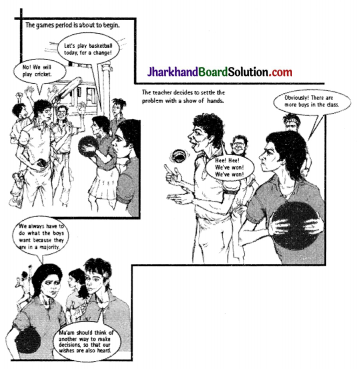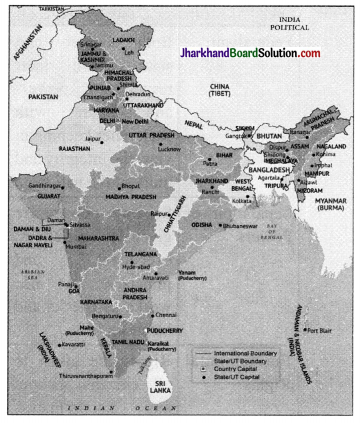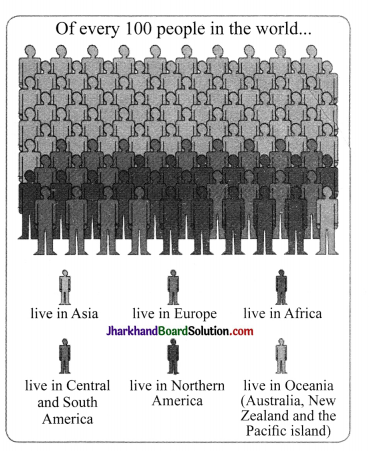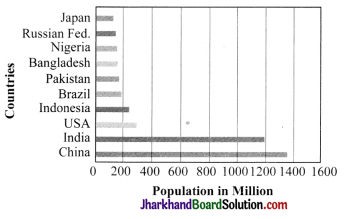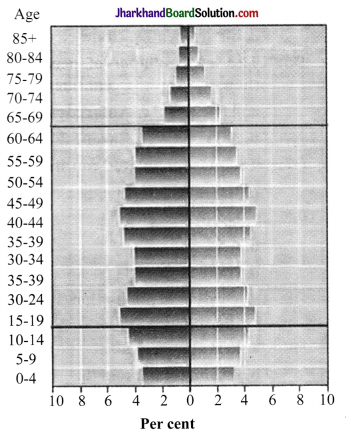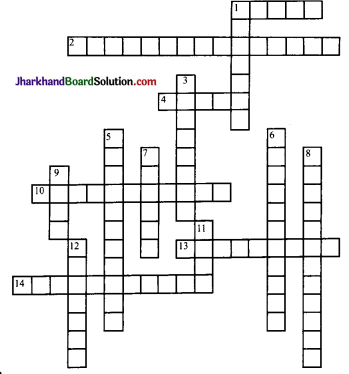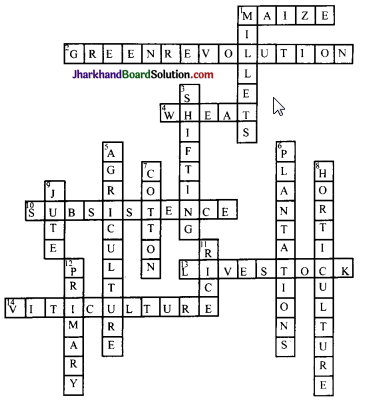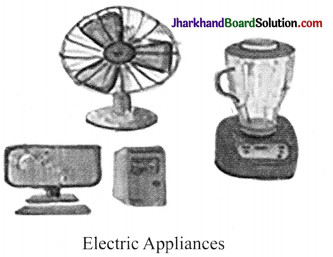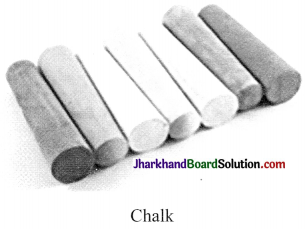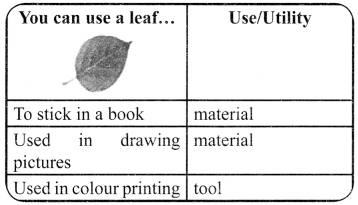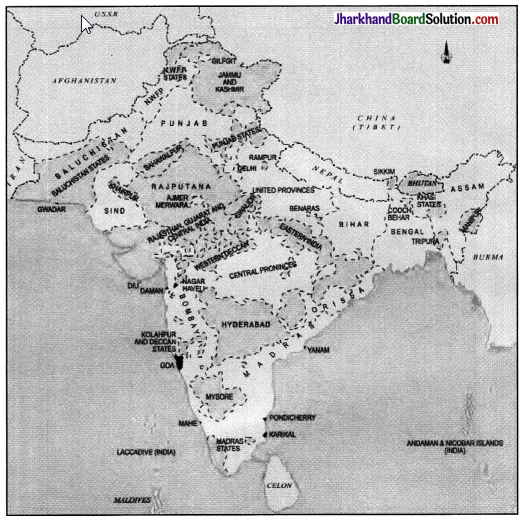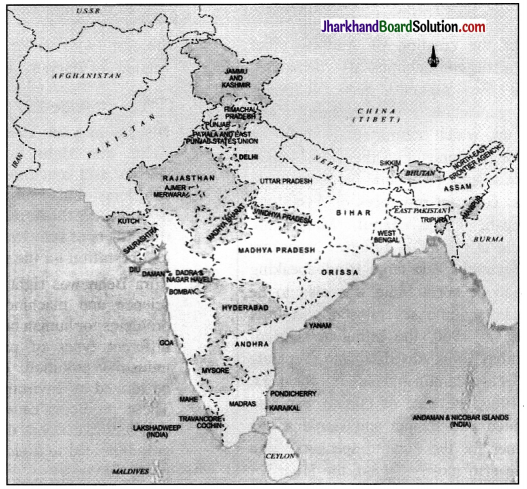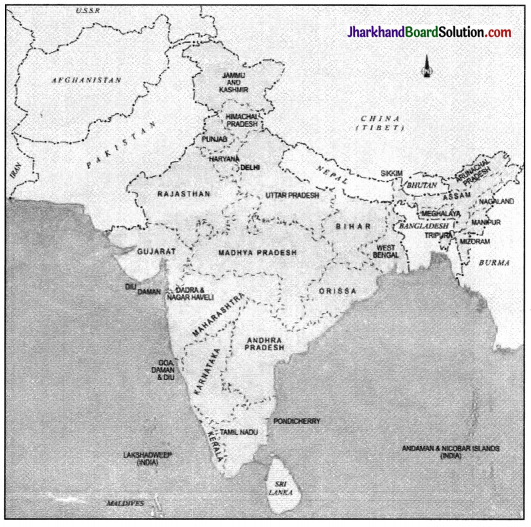JAC Board Class 8th Social Science Solutions History Chapter 7 Civilising the Native, Educating the Nation
JAC Class 8th History Civilising the Native, Educating the Nation InText Questions and Answers
Page 85
Question 1.
Imagine you are living in the 1850s. You hear of Wood’s Despatch. Write about your reactions.
Answer:
Students need to do it on their own.
Hint:
- As an Indian one would be quite as¬tonished to reject knowledge of the east in total.
- Wood’s Despatch identified grave errors in our education system.
- The British believed that by learn¬ing English education we would be more rational, scientific but they have failed to understand our most reversed spiritual text.
Page 88
Question 2.
Imagine you were born in a poor fam¬ily in the 1850s. How would you have responded to the coming of the new system of government regulated path- shalas?
Answer:
I would have responded against the new system of government regulated pathshalas because children from poor families like me were able to attend the pathshala as the time table was flexible but the new system don’t have flexibility and have strict rules.
![]()
Question 3.
Did you know that about 50 per cent of the children going to primary school drop out of school by the time they are 13 or 14? Can you think of the various possible reasons for this fact?
Answer:
The various possible reason for this fact are:
- Poverty
- Unemployment
- Child labour
- Unavailability of schools in villages and backward areas
- Due to lack of knowledge and illiteracy, people don’t give importance to education.
Question 4.
Imagine you were witness to a debate between Mahatma Gandhi and Macaulay on English education. Write a page on the dialogue you heard.
Answer:
Students need to do it on their own with the help of teacher.
Hints:
Mahatma Gandhi:
In. the minds of millions of Indians, English education has created a feeling of inferiority.
Macauley:
People need to be more civilized and this can be done only by English education.
Mahatma Gandhi:
Education should be such that could help Indians to restore their self-respect and sense of dignity.
Macauley:
A single shelf of a good European Library is worth than the whole native Indian literature. And so on….
JAC Class 8th History Civilising the Native, Educating the NationTextbook Questions and Answers
(LePsRecair)
Question 1.
Match the following:
| William Jones | promotion of English education |
| Rabindranath Tagore | respect for ancient cultures |
| Thomas Macaulay | gurus |
| Mahatma Gandhi | learning in a natural environment |
| Pathshalas | critical of English education |
Answer:
| William Jones | respect for ancient cultures |
| Rabindranath Tagore | learning in a natural environment |
| Thomas Macaulay | promotion of English education |
| Mahatma Gandhi | critical of English education |
| Pathshalas | gurus |
Question 2.
State whether true or false:
(a) James Mill was a severe critic of the Orientalists.
(b) The 1854 Despatch on education was in favour of English being introduced as a medium of higher education in India.
(c) Mahatma Gandhi thought that promotion of literacy was the most important aim of education.
(d) Rabindranath Tagore felt that children ought to be subjected to strict discipline.
Answer:
(a) True
(b) True
(c) False
(d) False
(Let’s Discuss)
Question 3.
Why did William Jones feel the need to study Indian history, philosophy and law?
Answer:
William Jones felt the need to study Indian history, philosophy and law because only those texts could reveal the real ideas and laws of the Hindus and Muslims and only a new study of these texts could form the basis of future development in India.
![]()
Question 4.
Why did James Mill and Thomas Macaulay think that European education was essential in India?
Answer:
James Mill and Thomas Macaulay thought that European education was essential in India because the education should be useful and practical. They also thought that Indians are need to be civilized and should be made familiar with the Western culture and modernisation.
Question 5.
Why did Mahatma Gandhi want to teach children handicrafts?
Answer:
Mahatma Gandhi wanted to teach children handicrafts because he felt that education ought to develop a person’s mind and soul. Literacy to read and write by itself did not count as education. People had to work with their hands, team a craft, and know how different things operated This would develop their mind and their capacity to understand.
Question 6.
Why did Mahatma Gandhi think that English education had enslaved Indians?
Answer:
Mahatma Gandhi thought that English education had enslaved Indians because of the following reasons:
- British education created a sense of inferiority in the minds of Indians.
- It made them see Western civilisation as superior and destroyed the pride they had in their own culture.
- Indians educated in these institutions began admiring British rule.
(let’s Do)
Question 7.
Find out from your grandparents about what they studied in school.
Answer:
Students need to do it on their own.
Question 8.
Find out about the history of your school or any other school in the area you live.
Answer:
Students need to do it on their own.
(Hint: Can write about as when the school was built and who built it. How many students are there? How the ‘ students make the school proud?)
JAC Class 8th History Civilising the Native, Educating the NationImportant Questions and Answers
Multiple Choice Questions
Question 1.
William Jones, a junior judge in Supreme court arrived in Calcutta in the year .
(a) 1785
(b) 1783
(c) 1789
(d) 1790
Answer:
(b) 1783
![]()
Question 2.
……….. started the Asiatic Society of Bengal.
(a) William Jones
(b) Henry Thomas Colebrooke
(c) Nathaniel Halhed
(d) All of these
Answer:
(d) All of these
Question 3.
………. felt that the Indian languages should be the medium of teaching.
(a) Mahatma Gandhi
(b) Rabindranath Tagore
(c) Subhash Chandra Bose
(d) William Jones
Answer:
(a) Mahatma Gandhi
Question 4.
The poet who reacted against the introduction of Western education in India was………
(a) Premchand
(b) Rabindranath Tagore
(c) Sarojini Naidu
(d) None of the above
Answer:
(b) Rabindranath Tagore
Question 5.
William Carey was a…..
(a) Teacher
(b) British Officer
(c) Scottish missionary
(d) Merchant
Answer:
(c) Scottish missionary
Question 6.
In 1781, a madrasa was set up in ………to promote the study of Arabic, Persian and Islamic law.
(a) Calcutta
(b) Delhi
(c) Bombay
(d) Surat
Answer:
(a) Calcutta
Question 7.
The English Education Act was introduced in the year.
(a) 1855
(b) 1846
(c) 1875
(d) 1835
Answer:
(d) 1835
Question 8.
Charles Wood was the:
(a) President of the Board of Control of the Company.
(b) Governor General in India.
(c) Viceroy.
(d) English Professor.
Answer:
(a) President of the Board of Control of the Company.
Question 9.
In Shantiniketan, school was started by
(a) Aurobindo Ghose
(b) Mahatma Gandhi
(c) Sardar Vallabh Bhai Patel
(d) Rabindranath Tagore
Answer:
(d) Rabindranath Tagore
![]()
Question 10.
Adam found that there were over ….. pathshalas in Bengal and Bihar.
(a) 2 lakhs
(b) 3 lakhs
(c) 1 lakhs
(d) 4 lakhs
Answer:
(c) 1 lakhs
Very Short Answer Type Question
Question 1.
What do you mean by linguist?
Answer:
A linguist is a person who knows and studies several languages.
Question 2.
William Jones was a linguist as well. What languages he knew?
Answer:
William Jones knew Greek, Latin, French, English, Arabic, Persian and Sanskrit.
Question 3.
Who sharply attacked the orientalists?
Answer:
James Mill and Thomas Babington Macaulay attacked the Orientalists.
Question 4.
Who had the opinion that Colonial education created sense of inferiority in the minds of Indians?
Answer:
Mahatma Gandhi had the opinion that Colonial education created sense of inferiority in the minds of Indians.
Question 5.
In which places the universities were first established by the company in India?
Answer:
Calcutta, Madras and Bombay were the places where the universities were first established by the company in India.
Question 6.
Which year did the East India Company decide to improve the system of vernacular education?
Answer:
After 1854 the Company decided to improve the system of vernacular education.
Question 7.
What do you mean by Orientalists?
Answer:
Orientalists are those who had a scholarly knowledge of the language and culture of Asia.
![]()
Question 8:
In pathshalas, what kind of education was given to the children?
Answer:
In pathshalas, teaching was oral and the guru decided what to teach in accordance with the needs of the students.
Question 9.
What type of task was assigned to the pandit by the Company?
Answer:
The type of task was assigned to the pandit by the Company was to visit the pathshalas and try to improve the standard of teaching.
Question 10.
In which way were Oriental institutions like the Calcutta Madrasa and Benaras Sanskrit College viewed by the British?
Answer:
The Oriental institutions like the Calcutta Madarsa and Benaras Sanskrit College were viewed as ‘temples of darkness that were falling of themselves into decay’.
Short Answer Type Question
Question 1.
What was the reason for the establishment of the Hindu College in Benaras?
Answer:
The reason for the establishment of the Hindu College in Benaras in 1791 was to encourage the study of ancient Sanskrit texts that would be useful for the administration of the country.
Question 2.
In which way Mahatma Gandhi view literacy?
Answer:
Mahatma Gandhi viewed literacy as not the end of education nor even the beginning. It is only one of the means whereby men and women can be educated Literacy in itself is not education.
Question 3.
What did Thomas Macaulay urge the British government in India?
Answer:
Thomas Macaulay urged that the British government in India stop wasting money in promoting Oriental learning as it was of no practical use.
Question 4.
The East India Company opposed to missionary activities in India. Why?
Answer:
Until 1813, the East India Company was opposed to missionary activities in India because it feared that missionary activities would provoke reaction amongst the local population and make them suspicious of British presence in India.
Question 5.
What do you understand by Wood’s Despatch?
Answer:
The Court of Directors of the East India Company in London in 1854 sent an educational dispatch to the Governor General in India. This was issued by Charles Wood, the President of the Board of the Company and hence, it has come to be called as Wood’s Despatch.
![]()
Question 6.
What were the provisions of English Education Act of 1835?
Answer:
The provisions of English Education Act of 1835 were as follows:
- English was made the medium of instruction for higher education.
- Promotion of Oriental institutions such as the Calcutta Madrasa and Benaras Sanskrit College was stopped These institutions were seen as ‘temples of darkness that were falling of themselves into decay’.
- English textbooks began to be produced for schools.
Question 7.
Explain the measures introduced by the British following the 1854 Wood’s Despatch.
Answer:
Following the 1854 Wood’s Despatch, several measures were introduced by the British as follows:
- Education departments of the government were set up to extend control over all matters regarding education.
- Steps were taken to establish a system of university education. Universities were established in Calcutta, Madras and Bombay.
- Attempts were also made to bring about changes within the system of school education.
Question 8.
Many British officials criticised the Orientalists. Why?
Answer:
From the early nineteenth century many British officials criticized the Orientalist vision of learning because they said that knowledge of the East was full of errors and unscientific thoughts. Eastern literature was non-serious and light-hearted Hence, they argued that it was wrong on the part of the British to spend so much effort in encouraging the study of Arabic and Sanskrit language and literature.
Question 9.
William Jones discover many things in Calcutta. What were they?
Answer:
William Jones mainly discovered the ancient Indian heritage. He discovered through his studies on ancient Indian texts on law, religion, arithmetic, medicine, science, philosophy. Soon he discovered that the interests were shared by many British officials living in Calcutta that time.
Question 10.
List the main features of educational method followed in pathshalas.
Answer:
The main features of educational method followed in pathshalas were as follows:
- There were no formal schools.
- Teaching was oral and guru decided what to teach.
- The system of education was flexible.
- In some places, classes were held in open spaces.
- There were no fixed school fees, no books, no annual exams, no regular time-table.
Long Answer Type Question
Question 1.
Describe in brief the irregularities of pathshalas which were checked by the Company.
Answer:
Steps taken by the Company to check the irregularities of pathshalas were:
- It appointed a number of government pandits. Each incharge of four to five schools. The task of the pandit was to visit the pathshalas and try to improve the standard of teaching.
- Each guru was asked to submit periodic reports and take classes according to a regular timetable.
- Teaching was now to be based on textbooks and learning was to be tested through a system of annual examination.
- Students were asked to pay a regular fee, attend regular classes, sit on fixed seats and obey the new rules of discipline.
Question 2.
Which type of education did Mahatma Gandhi want in India?
Answer:
Mahatma Gandhi’s views on education was as follows:
- Mahatma Gandhi wanted an education that could help Indians recover their sense of dignity and self-respect.
- Mahatma Gandhi strongly felt that Indian languages should be the medium of teaching. Education in English crippled Indians, distanced them from their own social surroundings, and made them ‘strangers in their own lands’.
Civilising the “Native”, Educating the Nation - Speaking a foreign tongue, despising local culture, the English educated did not know how to relate to the masses.
- He argued that education ought to develop a person’s mind and soul. Literacy to read and write by itself did not count as education.
- People had to work with their hands, learn a craft, and know how different things operated This would develop their mind and their capacity to understand.
Question 3.
Explain about Rabindranath Tagore and his school Shantiniketan.
Answer:
Rabindranath Tagore like many, also did not approve Western education wholeheartedly. At the time when several Indians urged the British to open more and more schools, colleges and universities in order to spread English education in India, Rabindranath Tagore reacted strongly against such education. He was a great educationist though he hated going to school because he saw it oppressive. In fact, he wanted to establish a school where the children were happy and were free to explore their thoughts and desires without feeling any suppression.
![]()
He advocated for giving children natural surroundings where they would be able to cultivate their natural creativity. In the year 1901, Rabindranath Tagore established Shantiniketan. He regarded it as an ‘abode of peace’. He set up his school 100 kilometres away from Calcutta in a rural setting in order to provide children a very peaceful environment. Here, they could develop their imagination and creativity. Tagore had the opinion that existing schools were killing the natural desires of the children to be creative. Hence, it was necessary to help them develop their curiosity by providing them good teachers who could understand them. By establishing an institution like Shantiniketan he did a great job in the field of education.
